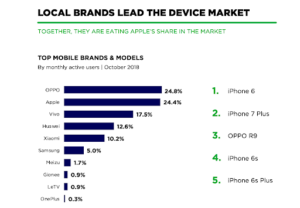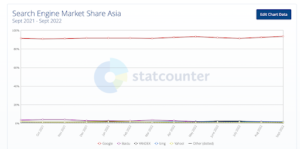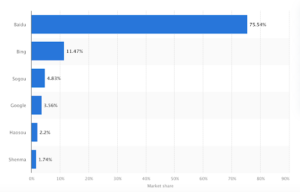The Asian market is considered one of the most specific regarding localizing websites and mobile apps. However, the potential benefits are worth all the challenges you might need to solve.
Statista reports that most revenue is generated in China, predicting US$156.60bn in 2022, when the total revenue is projected to reach US$430.90bn. And this is only China: Singapore, Korea, India, and Japan should also be taken into account.
But is it challenging to get your app or website localized for the Asian region? How do website localization services for the Asian market differ from the USA or Europe?
Let’s dive into essential things to remember when you’ve decided to enter an Asian market.
1. Consider Devices People Use
Not everyone is hunting for the latest iPhones after the Apple presentation. Android OS is a dominant mobile operating system in Asia, about 80%.

When localizing, considering information about devices is quite important. Devices influence your UX/UI, ASO (App Store Optimization), and even code localization. For example, if you’re entering the Asian market, you should focus more on optimizing the Google Play Market page than the App Store one.
Also, remember that, for instance, the Chinese network speed is lower than the European. Thus, you need to make sure that you don’t have some heavy data, as your app can even be abandoned in the Asian app markets.
2. Keywords Matter
To make your app or website visible to new users, you need to take care of keywords. It concerns both SEO and ASO.
For SEO, it’s essential to know what search engine is the most used in the market you want to enter. In the Asian market, there are no big surprises: Google. So, you need to find keywords that will boost your page rate in the APAC region. You can use such tools as Google Trends or Keyword Planner. Also, you can take advantage of third-party tools that analyze competitors’ keywords and help to create a strong semantic core.

But you must remember that the Asian market differs from country to country. Google is not the leading scratch engine in China: Baidu takes first place. Thus, you need to consider how to make your website visible there.

When it comes to ASO, things are a bit different. In the Asian region, Google Play is not working, and the Apple App Store has a different version. For example, China has a unique app store ecosystem — Huawei App Market has a 44.31% market share of all mobile apps. Therefore, you need to consider the new app stores and think about how you’ll promote your app there.
Consider creating new keywords for every Asian country and finding new keywords depending on the mobile app store popular in this particular country.
3. Not All Asian Countries Are the Same
Keep in mind that even in China, there are seven Chinese dialects. To become successful in various markets, you need to see the difference between Korean and Indian cultures. It’s especially important for your marketing material and websites selling some services or goods.
We also recommend going for a professional software localization company with vast experience localizing content for various markets. Usually, such companies have native speakers who know the minor peculiarities of specific markets.
4. Texts Will Be Different in Sizes
It’s essential to remember that texts in Chinese, Japanese or any other Asian language are usually shorter than their European equivalents. Chinese texts are generally 20-30% shorter than English.
However, some Asian languages might take more horizontal and vertical space. For example, the English word ‘desktop’ becomes “デスクトップ” in Japanese, which obviously takes both more horizontal and vertical place.
While designing your website or mobile app for the Asian market, you must ensure that all the buttons have enough space to fit in Asian language texts.
5. Adapt Visual Part
The visual part is another important element to be changed for the Asian market. Visuals differ a lot if we compare Asian and European website versions. The picture below shows that the German version of Adidas’ website is more minimalistic than the Japanese one.


Marketing teams say that bright colors sell better in Asia, particularly in China. Therefore, when expanding to the Asian region, you need to escape white and black website color schemes. You’d better add some bright colors to attract an Asian audience.
6. Know Your Marketing Channels
To make your app, website, or brand visible to an Asian audience, you need to understand what marketing channels work there.
In South Korea, influence marketing, from K-pop groups to micro-influencers and celebrities, is a perfect way to present your new product or service.
Also, remember that some traditional holidays do not exist in Europe (or are not so popular). For example, in Indonesia, there is a National Online Shopping Day known as Harbolnas. Therefore, if you’re entering the Indonesian market, you need to prepare your website and marketing campaign to rock this holiday and get some revenue benefits from it.
7. Test Your App
Testing is a step as essential as the app development itself. It’s necessary to check that everything is working smoothly in a new market:
- All fonts are displayed correctly.
- Pictures are relevant.
- There are no English texts in the app or website.
Always beta-test your website or mobile app with the native audience. This is a sure way to notice any problems or misleading things. It’s better to prevent them than find them only after the launch.
Also, you can test your app or website in one of the countries in Asian markets and only then realize it to all of them if no problems occur.
Wrapping Up…
Indeed, the Asian market is not the easiest one to enter. It would help if you did a lot of preparations before showing your website or mobile app to your new target audience. Wise preparatory work will increase your chances of rocking the Asian market.
And going for professional software localization services will make this path easier for you.




